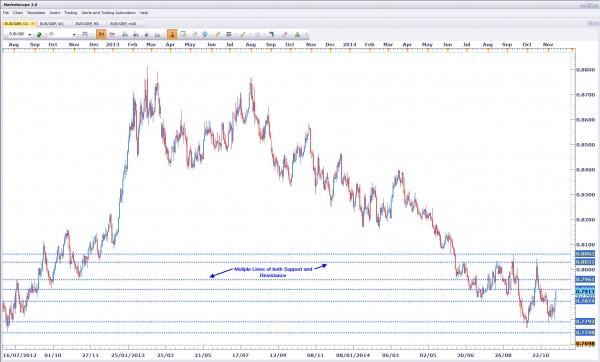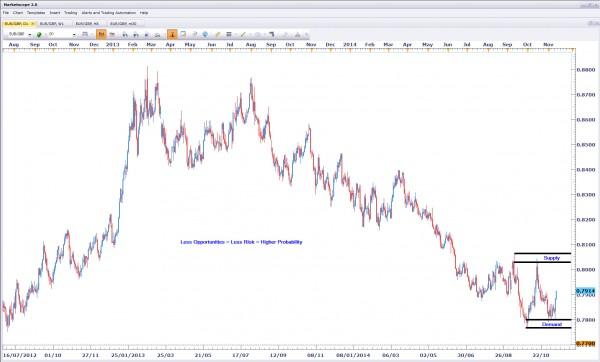![]()
Coming up with the title and topic of this week’s article was a simple task for me this time around, as it was directly inspired by a question that I received from a regular reader of these articles. As you know I do like to respond to my readers e-mails as often as I can and when a great topic is brought up during those communications, I always like to address it directly to a wider audience, as I’m sure that the question is not exclusive to just one person alone. Earlier this week I was e-mailed and asked why I very rarely talk about the terms “support and resistance.” The writer asked me how I could ignore such huge analysis techniques in my articles because support and resistance are so well known across-the-board and in multiple formats of technical analysis education. This gave me the perfect opportunity to address this and answer the question directly.
The beauty of the Online Trading Academy patented core strategy is in its simplicity and ease of execution. With the strategy itself coming directly from the behavioral patterns of the largest institutions and banks who dominate today’s markets, our instructors and students alike, tend to focus on their trading opportunities from the perspective of what the most successful professional traders are using to carry out their own analysis techniques. While there are multiple streams of strategies and theories about how and why prices move in the manner they do, this doesn’t always mean that they are necessarily the correct ones. I will never be surprised by how many people assume that successful trading in the currency markets and also the other asset classes is a highly complex practice. After all, we are making it our business to predict the future I guess and so that dynamic alone tends to raise questions of how challenging trading can be.
Firstly, I would like to shut up all illusions before we go any further: nobody knows what is going happen next in any market. In fact one of the most important lessons that I ever learned early in my career was to approach the market every day with the assumption that I really didn’t know what was going to come next. This helped to alleviate any biases or subjective analysis leaving me unemotional and objective in the process of trading. With this taken into account, it should be obvious to us then, that the only thing that really matters is price and why it moves in the manner in which it does. Prices change and markets go up and down purely as a result of the ongoing changes in supply and demand at any given time. If prices rally higher, this is because there were more willing buyers than sellers, or put simply, because demand was greater than supply. When we see prices fall we know that supply was now greater than demand due to the undeniable fact that there were more willing sellers than buyers at the point of the directional price change.
With these basic and fundamental lessons taken into account, let’s now address the question of the role of support and resistance and how effective it can be when used as an analysis technique in our trading. Pick up any textbook or look at any website about conventional technical analysis and you will no doubt find A number of simple rules around support and resistance. They are as follows:
1 – Buy at or near Support
2 – Sell at or near Resistance
3 – Old Support becomes new Resistance
4 – Old Resistance becomes new Support
Trust me, I have scoured a wealth of trading educational content over the years in which I’ve been active in the markets and without a shadow of doubt, the rules above are pretty much universal. Now, I am not saying in any way that using these rules is incorrect or that they don’t work. Personally I have seen many times when these support and resistance rules have proven their effectiveness. However, there must be a solid set of accompanying rules to go with these rules, so as to make them easier to implement and increase their effectiveness. Without a number of filters to accompany these rules, one can become easily confused and fall into the danger of overtrading. Let’s take a look at an example below to show you what I mean:
In this example of the EURGBP, I have drawn in a number of support and resistance lines. Upon referencing the previous rules, you will notice that support can become resistance and that also resistance can become support. With this in mind you’ll see how in the above example there are so many lines because support lines can be doubled up as resistance lines and vice versa, resulting in numerous reference points across our chart. In this example we have seven lines drawn on the chart, which could potentially provide seven individual trading opportunities to us. Buying, applying the aforementioned support and resistance rules from earlier, the question is now which line do we buy or sell at? And so the confusion begins… Now I am speaking completely from my own personal opinion right now but I would find it nearly impossible to decide upon which trading opportunity to take out of the above seven in this example. It becomes pretty much impossible to apply any level of objectivity when faced with so many choices. This is where the problem lies as more trading opportunities can result in lower probability and higher risk. Now we have the simple answer as to why I choose not to use regular support and resistance in my own trading. I would rather apply the dynamics of true institutional supply and demand to my chart and make my trading decisions from there. Let’s now take a look at the chart with the support and resistance lines removed and just a couple of key levels of demand and supply applied instead:
With our levels of supply demand now applied to the chart, the simplicity in opportunity is now so much more clearly defined. Until either of these levels are broken there is little else to do but sit on our hands and wait for a supply or demand level to present itself to us. The reason I choose to wait is because I want to see what the institutions are doing before I take action, rather than simply assuming a previous price level will provide me with a trading opportunity because it was once support or resistance. I can only truly go by what the market is telling me right now because what it was telling me in the past is no longer relative. Once a support or resistance level has been broken it is no longer valid. One of the negatives in some people’s opinions of supply and demand is that there are much fewer opportunities. However I do not believe this is a bad thing as I know from my experience it’s not about the frequency of trades that you take but instead the more important aspect is the quality itself of the trades that you find. Institutions wait for the best prices and show their footprints on the price chart if you know what you’re looking for. This is what we must also do if we hope to be successful in the currency markets as well.
Support and resistance may be common analysis techniques in the vast majority of educational content worldwide but they also are techniques employed by the vast majority of traders on the retail side of the markets as well, traders who more often than not struggle to make profits or breakeven. What this suggests to us is that using the common tools available to everybody else is more likely to get you the same results as everybody else unless you have an edge. In two weeks I will continue this discussion and look further into rules number three and four on our list, highlighting how they can often be widely misunderstood as potential training opportunities and can typically become potential traps for most.
Note: All information on this page is subject to change. The use of this website constitutes acceptance of our user agreement. Please read our privacy policy and legal disclaimer. Opinions expressed at FXstreet.com are those of the individual authors and do not necessarily represent the opinion of FXstreet.com or its management. Risk Disclosure: Trading foreign exchange on margin carries a high level of risk, and may not be suitable for all investors. The high degree of leverage can work against you as well as for you. Before deciding to invest in foreign exchange you should carefully consider your investment objectives, level of experience, and risk appetite. The possibility exists that you could sustain a loss of some or all of your initial investment and therefore you should not invest money that you cannot afford to lose. You should be aware of all the risks associated with foreign exchange trading, and seek advice from an independent financial advisor if you have any doubts.
Editors’ Picks
How will US Dollar react to Q1 GDP data? – LIVE

The US' GDP is forecast to grow at an annual rate of 2.5% in the first quarter of the year. The US Dollar struggles to find demand as investors stay on the sidelines, while waiting to assess the impact of the US economic performance on the Fed rate outlook.
EUR/USD holds gains above 1.0700, as key US data loom

EUR/USD holds gains above 1.0700 in the European session on Thursday. Renewed US Dollar weakness offsets the risk-off market environment, supporting the pair ahead of the key US GDP and PCE inflation data.
GBP/USD extends recovery above 1.2500, awaits US GDP data

GBP/USD is catching a fresh bid wave, rising above 1.2500 in European trading on Thursday. The US Dollar resumes its corrective downside, as traders resort to repositioning ahead of the high-impact US advance GDP data for the first quarter.
Gold price edges higher amid weaker USD and softer risk tone, focus remains on US GDP

Gold price (XAU/USD) attracts some dip-buying in the vicinity of the $2,300 mark on Thursday and for now, seems to have snapped a three-day losing streak, though the upside potential seems limited.
XRP extends its decline, crypto experts comment on Ripple stablecoin and benefits for XRP Ledger

Ripple extends decline to $0.52 on Thursday, wipes out weekly gains. Crypto expert asks Ripple CTO how the stablecoin will benefit the XRP Ledger and native token XRP.
RECOMMENDED LESSONS
Making money in forex is easy if you know how the bankers trade!
Discover how to make money in forex is easy if you know how the bankers trade!
5 Forex News Events You Need To Know
In the fast moving world of currency markets, it is extremely important for new traders to know the list of important forex news...
Top 10 Chart Patterns Every Trader Should Know
Chart patterns are one of the most effective trading tools for a trader. They are pure price-action, and form on the basis of underlying buying and...
7 Ways to Avoid Forex Scams
The forex industry is recently seeing more and more scams. Here are 7 ways to avoid losing your money in such scams: Forex scams are becoming frequent. Michael Greenberg reports on luxurious expenses, including a submarine bought from the money taken from forex traders. Here’s another report of a forex fraud. So, how can we avoid falling in such forex scams?
What Are the 10 Fatal Mistakes Traders Make
Trading is exciting. Trading is hard. Trading is extremely hard. Some say that it takes more than 10,000 hours to master. Others believe that trading is the way to quick riches. They might be both wrong. What is important to know that no matter how experienced you are, mistakes will be part of the trading process.


